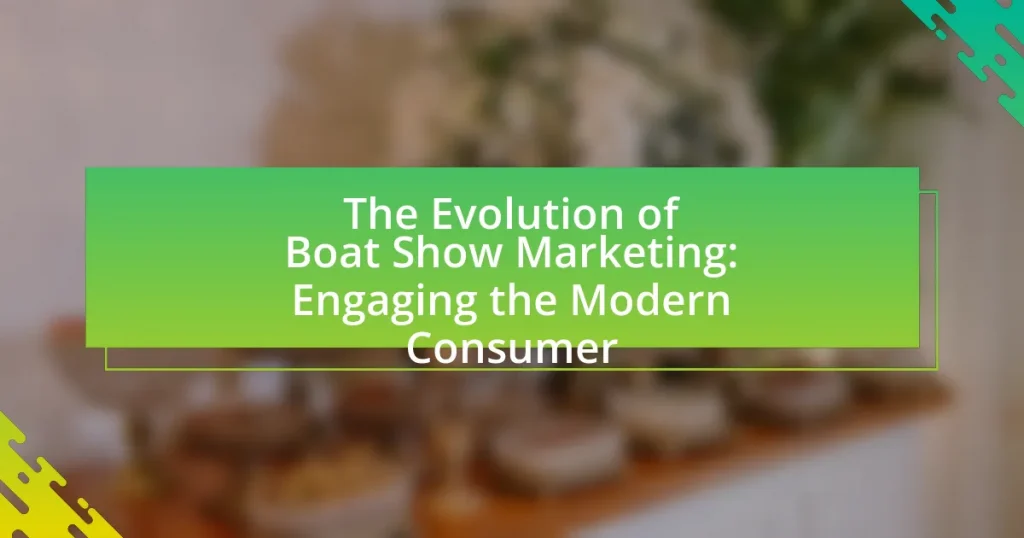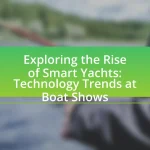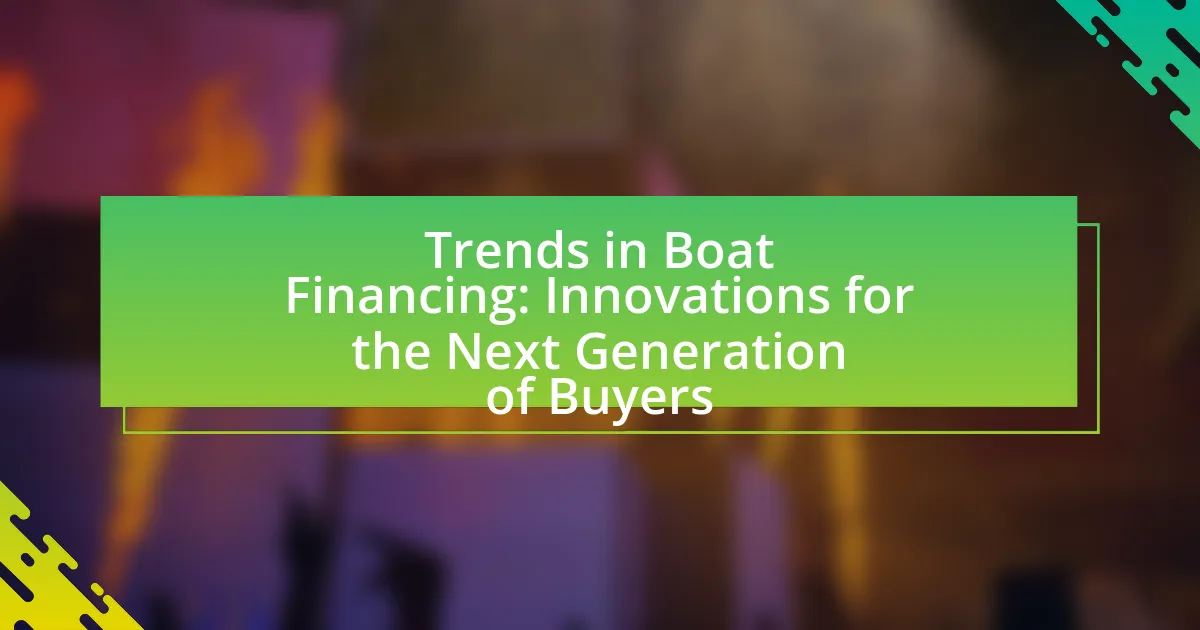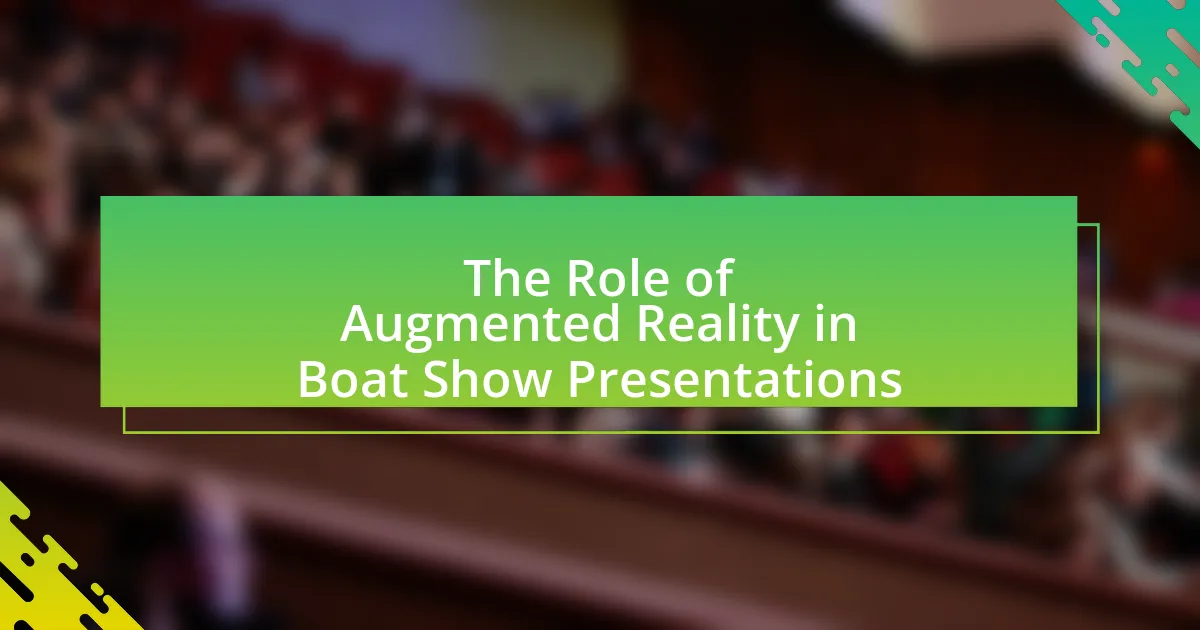The article examines the evolution of boat show marketing, highlighting the transition from traditional in-person exhibitions to a more integrated approach that incorporates digital platforms and experiential marketing. It discusses how technological advancements and changing consumer behaviors have influenced marketing strategies, emphasizing the importance of online engagement and personalized experiences. Key trends such as the use of social media, virtual reality, and sustainability are explored, along with insights into consumer preferences and behaviors that shape modern marketing tactics. The article also outlines best practices for effective engagement at boat shows, including the role of data analytics and experiential marketing in enhancing consumer interest and driving sales.
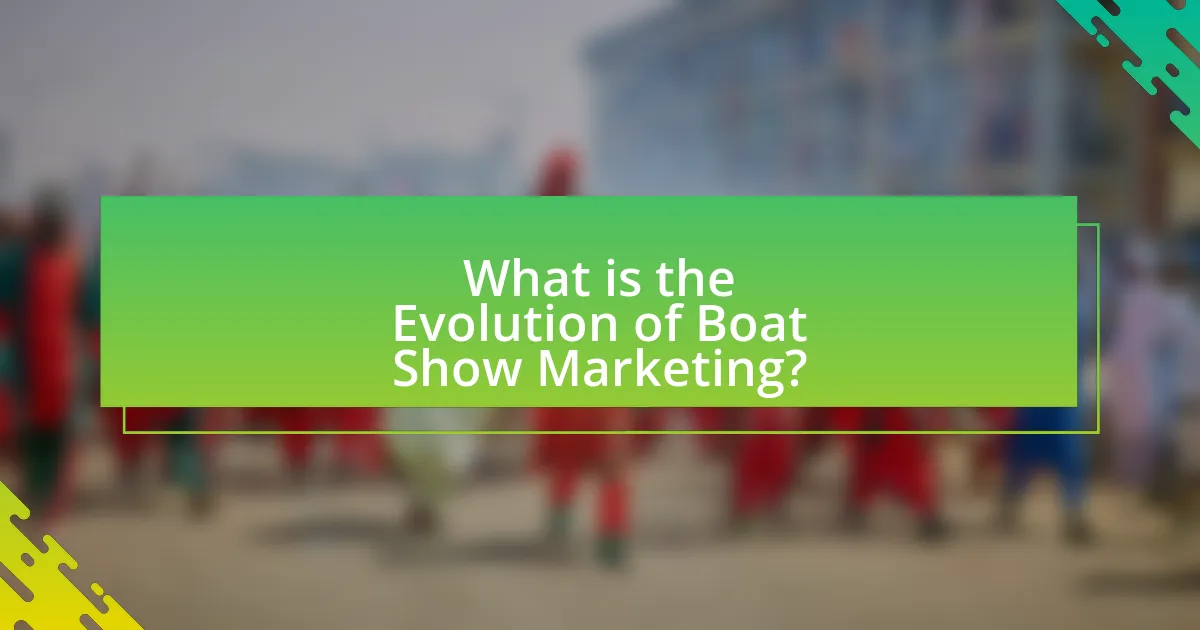
What is the Evolution of Boat Show Marketing?
The evolution of boat show marketing has transitioned from traditional in-person exhibitions to a more integrated approach that includes digital platforms and experiential marketing. Initially, boat shows primarily relied on physical displays and face-to-face interactions to attract potential buyers, showcasing a limited range of products in specific locations. Over time, advancements in technology and changes in consumer behavior prompted marketers to adopt online strategies, such as virtual boat shows and social media campaigns, allowing for broader reach and engagement. For instance, the introduction of live streaming and interactive online experiences during boat shows has enabled brands to connect with audiences who cannot attend in person, reflecting a shift towards a more consumer-centric approach. This evolution is supported by data indicating that 70% of consumers prefer to research products online before making a purchase, highlighting the importance of digital presence in modern marketing strategies.
How has boat show marketing changed over the years?
Boat show marketing has evolved significantly over the years, shifting from traditional print advertising and in-person promotions to a more digital and experiential approach. Historically, boat shows relied heavily on brochures, flyers, and face-to-face interactions to attract potential buyers. However, with the rise of digital technology, marketing strategies have incorporated social media, virtual reality experiences, and targeted online advertising to engage a broader audience. For instance, recent boat shows utilize live streaming and interactive online platforms to showcase products, allowing consumers to experience boats remotely. This transition reflects a broader trend in consumer behavior, where potential buyers increasingly seek information and experiences online before making purchasing decisions.
What historical factors influenced the evolution of boat show marketing?
The evolution of boat show marketing has been significantly influenced by technological advancements, economic conditions, and changing consumer preferences. Technological advancements, such as the introduction of digital marketing and online platforms, have transformed how boat shows promote their events and engage with potential customers. Economic conditions, particularly during periods of economic growth or recession, have affected consumer spending on recreational boating, thereby influencing marketing strategies. Additionally, changing consumer preferences towards experiential marketing and personalized experiences have led boat shows to adapt their marketing approaches to attract modern consumers. For instance, the rise of social media has prompted boat shows to utilize these platforms for real-time engagement and promotion, reflecting a shift in how marketing is conducted in the industry.
How have consumer preferences shaped boat show marketing strategies?
Consumer preferences have significantly influenced boat show marketing strategies by driving a focus on experiential engagement and personalized offerings. As consumers increasingly seek immersive experiences, boat shows have adapted by incorporating interactive displays, virtual reality simulations, and hands-on demonstrations to enhance visitor engagement. Additionally, the rise of eco-consciousness among consumers has prompted marketers to highlight sustainable boating options and environmentally friendly technologies, aligning product offerings with consumer values. This shift is supported by data indicating that 70% of boat buyers prioritize eco-friendly features, compelling marketers to adjust their messaging and product showcases accordingly.
Why is understanding this evolution important for marketers?
Understanding the evolution of boat show marketing is crucial for marketers because it enables them to adapt strategies that resonate with modern consumer behaviors. As consumer preferences shift towards digital engagement and personalized experiences, marketers must recognize these trends to effectively capture attention and drive sales. For instance, a study by the National Marine Manufacturers Association indicates that 70% of boat buyers conduct online research before attending a show, highlighting the need for marketers to integrate digital marketing strategies with traditional approaches. This understanding allows marketers to create targeted campaigns that align with consumer expectations, ultimately enhancing engagement and conversion rates.
What insights can be gained from the history of boat show marketing?
The history of boat show marketing reveals that targeted engagement strategies significantly enhance consumer interest and sales. Over the decades, boat shows have evolved from simple exhibitions to complex marketing platforms that utilize multimedia presentations, interactive displays, and experiential marketing techniques. For instance, the introduction of virtual reality experiences at boat shows has allowed potential buyers to engage with products in immersive ways, reflecting a shift towards technology-driven marketing. Additionally, historical data indicates that boat shows have consistently served as critical venues for networking among industry professionals, leading to partnerships and collaborations that drive innovation in product offerings. This evolution underscores the importance of adapting marketing strategies to meet changing consumer preferences and technological advancements.
How can marketers apply lessons from the past to current strategies?
Marketers can apply lessons from the past to current strategies by analyzing historical consumer behavior trends and adapting successful tactics to modern contexts. For instance, the use of experiential marketing at boat shows has roots in past events where hands-on demonstrations effectively engaged attendees. Historical data shows that interactive experiences increase consumer interest and lead to higher conversion rates; a study by Event Marketer found that 74% of consumers say engaging with branded events makes them more likely to purchase. By leveraging these insights, marketers can create immersive experiences that resonate with today’s consumers, ensuring relevance and effectiveness in their strategies.
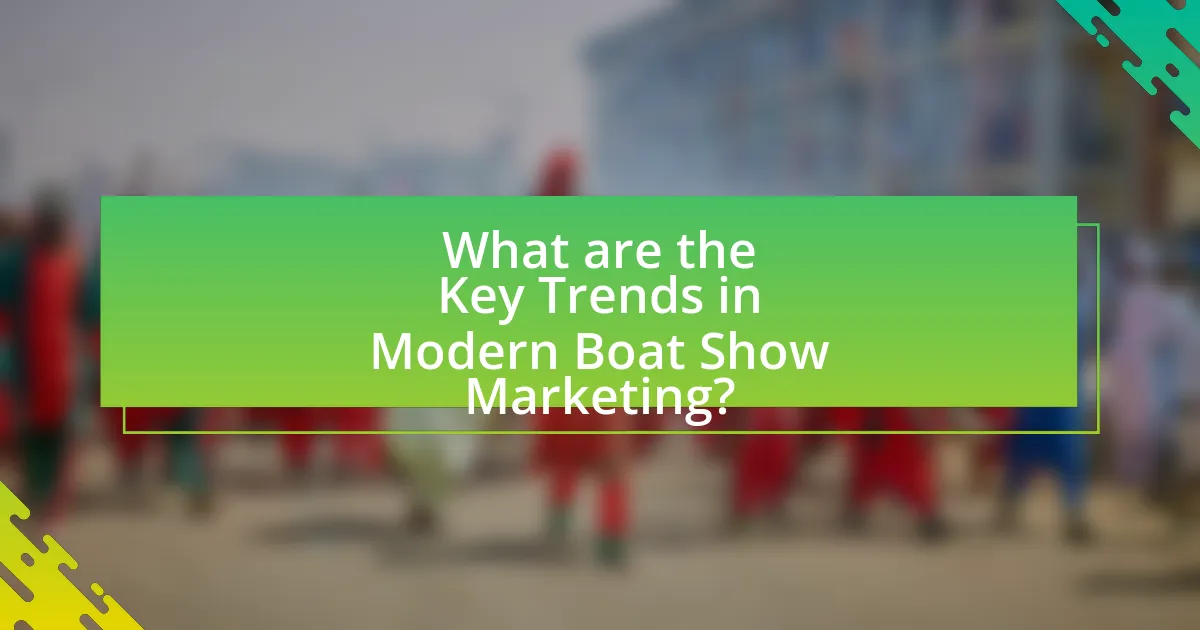
What are the Key Trends in Modern Boat Show Marketing?
Key trends in modern boat show marketing include the increased use of digital platforms, personalized marketing strategies, and experiential marketing. Digital platforms, such as social media and virtual reality, allow exhibitors to reach a broader audience and engage potential buyers before and after the event. Personalized marketing strategies leverage data analytics to tailor communications and offers to individual preferences, enhancing customer engagement. Experiential marketing focuses on creating immersive experiences for attendees, allowing them to interact with products in a meaningful way. According to a report by the National Marine Manufacturers Association, 70% of boat buyers attend boat shows, highlighting the importance of effective marketing strategies in this context.
How are digital technologies impacting boat show marketing?
Digital technologies are significantly transforming boat show marketing by enhancing engagement and reach through online platforms. Virtual reality (VR) and augmented reality (AR) allow potential buyers to experience boats in immersive environments, increasing interest and interaction. Additionally, social media marketing enables exhibitors to target specific demographics effectively, with platforms like Instagram and Facebook facilitating real-time engagement and feedback. According to a report by Statista, 54% of marketers believe that digital marketing strategies, including social media and online advertising, are crucial for reaching modern consumers. This shift towards digital engagement not only broadens the audience but also provides measurable insights into consumer behavior, allowing for more tailored marketing strategies.
What role do social media platforms play in engaging consumers?
Social media platforms play a crucial role in engaging consumers by facilitating direct interaction and fostering community around brands. These platforms enable businesses to share content, respond to inquiries, and create a dialogue with their audience, which enhances brand loyalty and consumer trust. For instance, a study by Sprout Social found that 70% of consumers feel more connected to brands with which they can engage on social media. This engagement is further amplified through user-generated content, where consumers share their experiences, thereby influencing potential buyers and creating a sense of authenticity.
How can virtual boat shows enhance consumer engagement?
Virtual boat shows enhance consumer engagement by providing interactive experiences that allow potential buyers to explore products in a dynamic online environment. These platforms often feature live demonstrations, Q&A sessions with experts, and virtual tours of boats, which create a more immersive experience compared to traditional boat shows. According to a report by the National Marine Manufacturers Association, virtual events can increase attendance by up to 300%, indicating a significant reach to consumers who may not attend in-person shows. This increased accessibility and engagement can lead to higher conversion rates, as consumers feel more informed and connected to the products being showcased.
What consumer behaviors are influencing boat show marketing today?
Consumer behaviors influencing boat show marketing today include increased digital engagement, a preference for experiential marketing, and a focus on sustainability. Digital engagement is evident as consumers increasingly research products online before attending shows, with 70% of boat buyers using online resources to inform their decisions. Experiential marketing is crucial, as attendees seek hands-on experiences and interactive displays, leading to higher engagement and conversion rates. Additionally, the growing emphasis on sustainability drives consumers to favor brands that demonstrate eco-friendly practices, with 55% of boat buyers considering environmental impact in their purchasing decisions. These behaviors shape marketing strategies to align with consumer expectations and preferences.
How do millennials and Gen Z approach boat shows differently?
Millennials and Gen Z approach boat shows differently primarily due to their distinct values and engagement methods. Millennials tend to prioritize experiential marketing and networking opportunities, often seeking hands-on experiences and social interactions at boat shows. In contrast, Gen Z focuses on digital engagement, utilizing social media and online platforms to research and share their experiences, often valuing authenticity and sustainability in their choices. For instance, a study by Eventbrite found that 78% of millennials prefer experiences over material goods, while Gen Z is more likely to engage with brands that demonstrate social responsibility. This difference in approach reflects broader generational trends in consumer behavior and preferences.
What factors drive consumer decisions at boat shows?
Consumer decisions at boat shows are primarily driven by product variety, pricing, brand reputation, and experiential engagement. The wide range of boats and related products available allows consumers to compare options directly, which influences their purchasing choices. Competitive pricing is crucial, as consumers often seek the best deals during these events. Brand reputation plays a significant role; established brands tend to attract more interest due to perceived reliability and quality. Additionally, experiential engagement, such as hands-on demonstrations and interactive displays, enhances consumer interest and can lead to immediate purchasing decisions. These factors collectively shape the consumer experience and influence their final choices at boat shows.
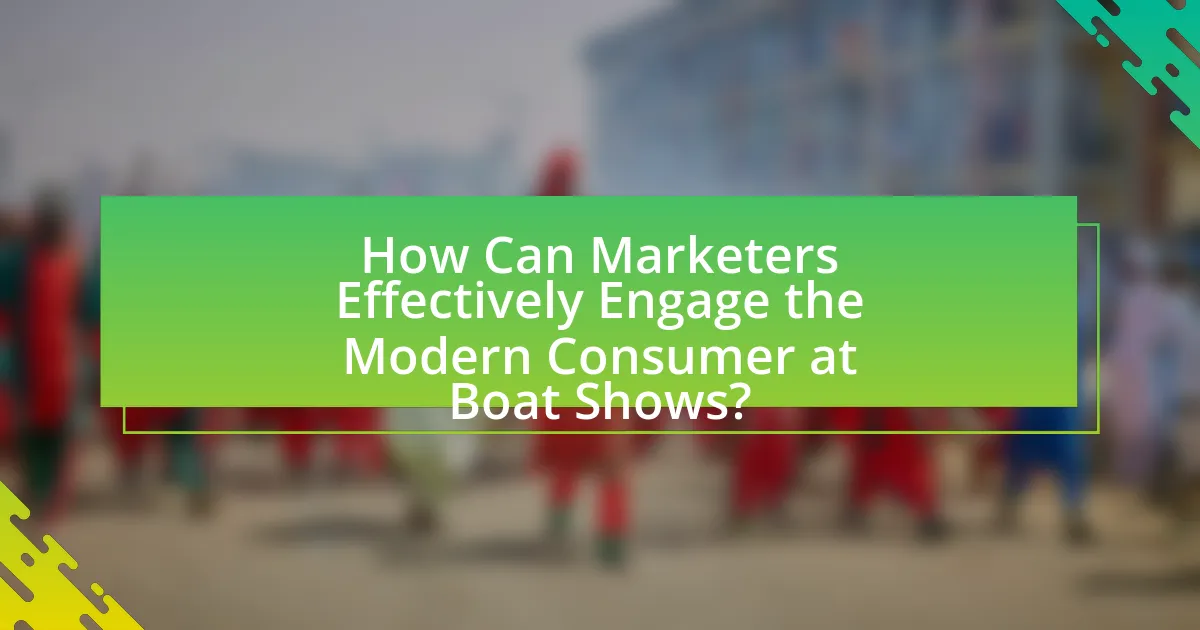
How Can Marketers Effectively Engage the Modern Consumer at Boat Shows?
Marketers can effectively engage the modern consumer at boat shows by utilizing interactive experiences and digital technology. Interactive displays, such as virtual reality simulations of boating experiences, allow consumers to immerse themselves in the product, enhancing their emotional connection. Additionally, leveraging social media platforms during the event can amplify engagement; for instance, live streaming product demonstrations or hosting contests encourages real-time interaction and sharing among attendees. According to a study by the Event Marketing Institute, 84% of consumers value in-person experiences, indicating that engaging formats significantly impact consumer interest and purchasing decisions.
What strategies can be implemented to attract modern consumers?
To attract modern consumers, businesses should implement strategies that leverage digital engagement, personalized experiences, and sustainability. Digital engagement can be achieved through targeted social media campaigns and interactive online content, which research shows increases consumer interest and participation. Personalized experiences, such as tailored recommendations and customized marketing messages, enhance customer satisfaction and loyalty, as evidenced by a study from McKinsey indicating that 71% of consumers expect companies to deliver personalized interactions. Additionally, emphasizing sustainability in products and practices resonates with modern consumers, with a Nielsen report revealing that 73% of millennials are willing to pay more for sustainable brands. These strategies collectively create a compelling approach to engage and attract today’s consumers effectively.
How can experiential marketing enhance consumer engagement at boat shows?
Experiential marketing enhances consumer engagement at boat shows by creating immersive experiences that allow potential buyers to interact directly with products. This hands-on approach fosters emotional connections, as consumers can test boats, participate in demonstrations, and engage with brand representatives in a dynamic environment. Research indicates that 70% of consumers are more likely to purchase a product after experiencing it firsthand, highlighting the effectiveness of experiential marketing in driving sales and brand loyalty. By facilitating memorable interactions, boat shows can significantly increase consumer interest and engagement.
What role does personalization play in marketing to boat show attendees?
Personalization plays a crucial role in marketing to boat show attendees by enhancing engagement and improving the overall customer experience. Tailored marketing strategies, such as personalized emails and targeted advertisements, resonate more effectively with attendees, leading to higher conversion rates. Research indicates that 80% of consumers are more likely to make a purchase when brands offer personalized experiences. By utilizing data analytics to understand attendee preferences and behaviors, marketers can create customized content that speaks directly to individual interests, thereby fostering a stronger connection and increasing the likelihood of sales at boat shows.
What are the best practices for successful boat show marketing?
Successful boat show marketing involves a combination of strategic planning, targeted outreach, and engaging presentations. First, exhibitors should identify their target audience and tailor their messaging to resonate with that demographic, ensuring that marketing materials highlight unique selling points of the boats on display. Additionally, leveraging digital marketing strategies, such as social media promotions and email campaigns, can effectively reach potential attendees before the event.
Moreover, creating an immersive experience at the show, such as interactive displays or virtual reality demonstrations, can significantly enhance visitor engagement. According to a study by the National Marine Manufacturers Association, 70% of boat show attendees are more likely to purchase after experiencing a hands-on demonstration.
Finally, post-show follow-ups through personalized communication can help convert leads into sales, reinforcing the importance of maintaining relationships with potential customers after the event.
How can data analytics improve marketing strategies for boat shows?
Data analytics can significantly enhance marketing strategies for boat shows by providing insights into consumer behavior and preferences. By analyzing data from previous events, marketers can identify trends such as popular boat types, peak attendance times, and effective promotional channels. For instance, a study by the National Marine Manufacturers Association found that targeted marketing based on demographic data increased attendance by 20% at boat shows. Additionally, real-time analytics during the event can help adjust marketing tactics on the fly, ensuring that promotions resonate with attendees. This data-driven approach allows for more personalized marketing, ultimately leading to higher engagement and sales conversions.
What are common pitfalls to avoid in boat show marketing?
Common pitfalls to avoid in boat show marketing include inadequate pre-show promotion, poor booth design, and lack of follow-up with leads. Inadequate pre-show promotion can lead to low attendance, as potential customers may not be aware of the event or your presence there. A poorly designed booth can fail to attract visitors, as it may not effectively showcase products or engage attendees. Additionally, neglecting to follow up with leads after the show can result in lost sales opportunities, as timely communication is crucial for converting interest into purchases. These pitfalls can significantly hinder the effectiveness of marketing efforts at boat shows.
What practical tips can marketers use to enhance their boat show presence?
Marketers can enhance their boat show presence by utilizing interactive displays and engaging demonstrations. Interactive displays attract attendees’ attention and encourage participation, which can lead to increased interest in products. For instance, incorporating virtual reality experiences allows potential customers to explore boats in a simulated environment, making the experience memorable. Additionally, offering live demonstrations of boat features or technology can showcase product capabilities effectively, as studies show that hands-on experiences significantly influence purchasing decisions. By combining these strategies, marketers can create a dynamic presence that resonates with modern consumers.
